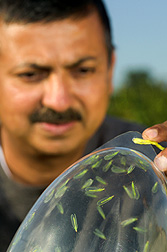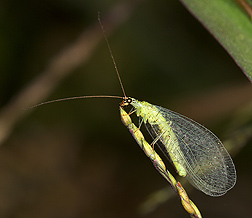A Natural Insect Attractant From Catnip
|
|
Discoveries in science can occur where and when least expected. For chemist Kamal Chauhan and entomologist Jeffrey Aldrich, an important finding came when they were testing a new compound for its potential as an insect repellent.
The researchers are with the ARS Chemicals Affecting Insect Behavior Laboratory, Beltsville, Maryland. They conducted a field study to test the repellent properties of a chemical compound they had separated from catnip oil. But they found that, instead of repelling insects, the compound attracted lacewings, which prey on several crop and garden pests.
Organic farmers and growers purchase lacewings as eggs or larvae to protect crops from aphids and mites. “They are an important, commercially available predator of these insects,” says Aldrich.
Attracting the Good Guys
Chauhan perfected a patent-pending method for separating compounds from catnip oil for possible agricultural use. Forms of one of these—Z,E-nepetalactone—attract both lacewings and aphids. But Chauhan found that a compound derived from Z,E-nepetalactone attracts only lacewings. It’s called “iridodial.”
Chauhan’s separation method offers an economical way to make large amounts of the desired compounds. This could lead to use by organic farmers interested in natural products that provide environmentally friendly biological controls for integrated pest management.
|
|
The Smell of Success
The male lacewing of the Chrysopa oculata species has roughly 10,000 individual glands on its abdomen, which release its pheromone, an attractant. The researchers tested the contents of the male lacewing’s abdomen and used sensitive instrumentation to measure reactions of the insect’s antenna when exposed to different chemical structures.
“We found that a relatively minor impurity from the catnip extract—iridodial—matched the chemical structure of the pheromone emitted from the male lacewing’s abdomen,” says Aldrich. “This is the first pheromone identified for any lacewing species within Neuroptera—an order of insects that includes thousands of members.”
Passing the Test
The lacewing attractant that Chauhan found is very potent—just 25 milligrams is sufficient to treat an acre of land. Results from a 2-year field study conducted by Chauhan and physical science technician Victor Levi show that the compound attracts both male and female lacewings, which later produce another generation of beneficial predators.
“Conceivably, if a farmer were to apply the compound as a lure, a local population of lacewings could be established naturally,” says Chauhan. Another positive is that the attractant is environmentally benign and remains active for 5 weeks, degrading slowly.
Chauhan is now working with Spokane, Washington-based Sterling International to commercialize formulations that attract specific beneficial insects. His work with Sterling entomologist Qing-He Zhang revealed that the same compound attracts three other lacewing species in the Pacific Northwest and Asia. More recent field studies in the south Atlantic plains revealed that the pheromone also attracts two Chrysopa species abundant there. Chauhan did this work with the help of entomologists Ted Cottrell, with ARS in Byron, Georgia, and Jim Dutcher, with the University of Georgia at Tifton.
A resulting product could relieve farmers of the need to repeatedly buy and release beneficial insect larvae.—By Rosalie Marion Bliss, Agricultural Research Service Information Staff.
This research is part of Veterinary, Medical, and Urban Entomology (#104), an ARS National Program described on the World Wide Web at www.nps.ars.usda.gov.
Kamal Chauhan is with the USDA-ARS Chemicals Affecting Insect Behavior Laboratory, 10300 Baltimore Ave., Bldg. 007, Room 303, Beltsville, MD 20705-2350; phone (301) 504-5166, fax (301) 504-6580.
"A Natural Insect Attractant From Catnip" was published in the May/June 2007 issue of Agricultural Research magazine.








